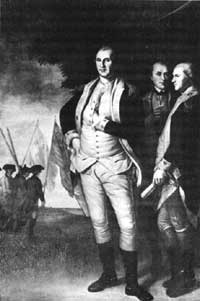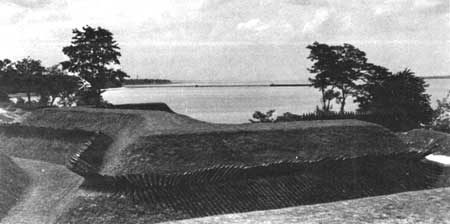|
YORKTOWN National Battlefield |
 |
Siege of Yorktown
(continued)
 Gen. George Washington, Commander in Chief of the allied French and American forces at Yorktown. (From the Peale portrait in the State House, Annapolis, Md.) |
INVESTMENT OF YORKTOWN. On September 27 all was in readiness for the movement of the allied armies against the British position at Yorktown and an "Order of Battle" was drawn up. At 5 o'clock in the morning of September 28 the French and American units, on instruction from Washington, their commander in chief, began to move toward Yorktown. The Continentals, followed by the French troops, formed the left column and the militia, the right. The route lay over the principal highways down the peninsula. At the "Halfway House," midway between Williamsburg and Yorktown, the American regulars moved off to the right, while the French continued on the more direct route.
About noon both sections approached Yorktown, and contact was made with British pickets who fell back. Lt. Col. Robert Abercrombie's Light Infantry, covering the British right, first gave the alarm, and some shots were exchanged with Tarleton's Legion, which covered the British left, as the American and French troops reached the approaches to Yorktown. By nightfall, the allied units reached temporary positions along Beaverdam Creek within a mile of the main enemy posts. At this point, orders were issued that "The whole army, officers and soldiers, will lay on their arms this night."
The investment of Yorktown, which began so auspiciously on the 28th, was more securely established during the 2 days that followed. On the 29th, the American wing moved more to the east (right) and nearer to the enemy, while both French and American units spread out to their designated campsites, forming a semicircle around Yorktown from the York River on the northwest to Wormley Creek, a tributary of the York, on the south and east. Reconnoitering was extended within cannon range of the enemy's works, and several skirmishes developed with British patrols. There was also some minor action at Moore's Dam over Wormley Creek, where the British had thrown up temporary positions.
BRITISH POSITION. When the British entered Yorktown in August 1781, the town, one of the most important in the lower Chesapeake region, was described by one of the soldiers as:
This Yorktown, or Little-York, is a small city of approximately 300 houses; it has, moreover, considerable circumference. It is located on the bank of the York River, somewhat high on a sandy but level ground. It has 3 churches, 2 reformed English and 1 German Lutheran, but without steeples, and 2 Quaker meeting houses, and a beautiful court or meeting house, which building, like the majority of the houses, is built of bricks. Here stood many houses which were destroyed and abandoned by their occupants. There was a garrison of 300 militia men here, but upon our arrival they marched away without firing a shot back to Williamsburg, which is 16 English miles from here.
We found few inhabitants here, as they had mostly gone with bag and baggage into the country beyond.
The task confronting Cornwallis was the fortification of this town and Gloucester Point, just across the York, as a base. In early August, he had little reason to expect that 2 months later he would be besieged. Nevertheless, on arrival in Yorktown he turned to the task at hand with vigor. As the days passed, Cornwallis began to realize that enemy forces were assembling around him.
In planning his defense, he established a line of fortifications, close in about the town, supported by small enclosed earthworks, or redoubts, and batteries. Just in advance of the main line he constructed two positions, Redoubts Nos. 9 and 10, to command the high ground in that sector. Along the York-Hampton Road he strengthened the main line by extending it outward on the highway in the form of a point, or wedge, that was called the "Horn-Work." In the inner and principal line, he had 10 redoubts and 14 batteries in which were mounted some 65 guns, the largest being 18-pounders. Some of this ordnance came from the British ships anchored offshore in the York.
The British outer line utilized the protective features of ravines and creeks. Close on the west of Yorktown was Yorktown Creek. On the east, but at a greater distance, ran Wormley Creek. These creeks, with their marshes and irregular terrain, constituted rather formidable barriers to the rapid advance of troops. The area between the headwaters of these two creeks, however, was a weak link. This high ground, less than half a mile wide, carried the road from Yorktown to Hampton. To control this, British engineers laid out four redoubts and some gun emplacements. On the west side of Yorktown Creek, near the point where a road to Williamsburg crossed, a large star-shaped work was built. This, manned by a part of the Royal Welch Fusiliers (23d) Regiment, was known as the Fusiliers Redoubt. These positions, some works at Moore's Mill Dam, and the two creeks constituted the British outer line at Yorktown.

The Fusiliers Redoubt (reconstructed), a position
which supported the right side of the British main
line.
The village at Gloucester Point, across the river, was fortified with a single line of entrenchments with 4 redoubts and 3 batteries. In the York River, between Yorktown and Gloucester, there were British transports, supply boats, and some armed vessels, notably the Charon and Guadaloupe.
Behind his lines, Cornwallis had a force of some 7,500 troops, most of them seasoned veterans. To aid his gunners, all buildings, trees, and other obstructions in front of his mainline were removed for a distance of 1,000 yards. All roads were blocked, and the completion of fixed positions was pushed.
Cornwallis had begun to feel the pinch of the French fleet blockade even before the allied armies reached Yorktown. On September 11, one of his soldiers wrote: "We get terrible provisions now, putrid ship's meat and wormy biscuits that have spoiled on the ships. Many of the men have taken sick here with dysentery or the bloody flux and with diarrhea. Also the foul fever is spreading, partly on account of the many hardships from which we have had little rest day or night, and partly on account of the awful food; but mostly, the nitrebearing water is to blame for it." Sickness and also a lack of officers were to remain a severe handicap for the British.
Cornwallis continued to keep in touch by letter with Clinton in New York. On September 16, he had received word that Clinton was planning to move south with a sizeable force to aid him. When he received this word, Cornwallis decided against any offensive action and so wrote to Clinton. On September 29, a dispatch from New York, written on the 24th, told of ship repairs and a strengthened British fleet, as well as the preparation of reinforcements for Cornwallis' Virginia garrison. Clinton continued: "There is every reason to hope we start from hence the 5th October."
About 10 o'clock on the night of September 29, Cornwallis made an important decision which he described in a letter to Clinton: "I have this evening received your letter of the 24th, which has given me the greatest satisfaction. I shall retire this night within the works, and have no doubt, if relief arrives in any reasonable time, York and Gloucester will be both in possession of his Majesty's troops." This decision to abandon his outer line without a fight definitely shortened the siege of Yorktown. It was a move for which Cornwallis has been criticized and an advantage which the allied armies quickly seized.

|

| History | Links to the Past | National Park Service | Search | Contact |
|
Last Modified: Mon, Dec 2 2002 10:00:00 am PDT |

